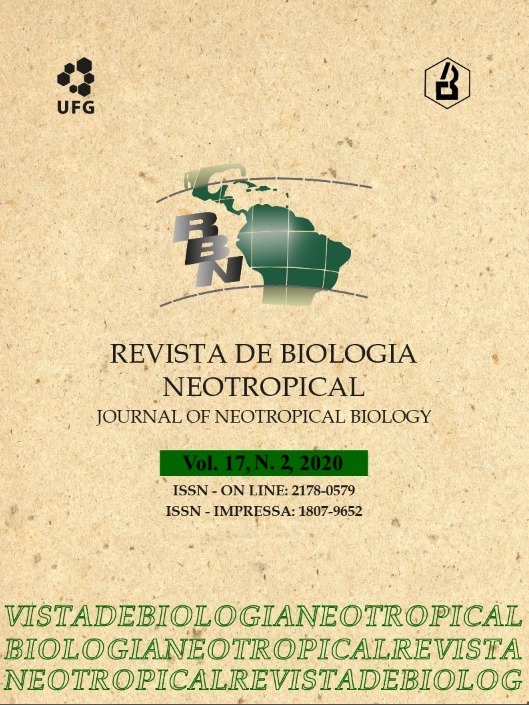Biochemical biomarkers in nile tilapias (Oreochromis niloticus Linnaeus, 1758) of different weights exposed to contaminants
DOI:
https://doi.org/10.5216/rbn.v17i2.63433Keywords:
biomarkers, contaminants, enzymes, tilapia, weightsAbstract
Nile tilapias (Oreochromis niloticus) of three groups with different weights (juvenile, adults of lower and higher weight) were exposed to benzo[a]pyrene (0.5 mg.L-1), cupper (0.5 mg.L-1), cadmium (0.5 mg.L-1) and diazinon (1.0 mg.L-1), for 72 h. In order to determine how animals of the same species respond to such contaminants over weight gain, biochemical biomarkers (glutathione S-transferase, superoxide dismutase, catalase, glutathione peroxidase, acetylcholinesterase, carboxylesterase and lipid peroxidation levels) were analyzed in liver and in gills. In the juvenile group the catalase was induced by exposure to cupper in gills, while lipid peroxidation levels were low. In the same group the glutathione S-transferase was induced in gills, likewise glutathione peroxidase was induced by diazinon in liver. In gills of the group of adults of lower weight the low lipid peroxidation levels, in exposure to diazinon treatment, may be related to inhibition of carboxylesterase. In the group of adults of higher weight was not observed adverse effect of contaminants, except for exposure to diazinon in esterases. Thus, this study prove clear evidence that it is necessary to take into account in biomonitoring programs, the weight, the tissue and the development, when using tilapia as tested organism.
Downloads
References
Abdelkhalek, N. K. M., E. W. Ghazy & M. M. Abdel-Daim. 2015. Pharmacodynamic interaction of Spirulina platensis and deltamethrin in freshwater fish Nile tilapia, Oreochromis niloticus: impact on lipid peroxidation and oxidative stress. Environ. Sci. Pollut. Res. 22: 3023–3031. DOI: https://doi.org/10.1007/s11356-014-3578-0
Ahmad, I., M. Pacheco & M. A. Santos. 2004. Enzymatic and nonenzymatic antioxidants as an adaptation to phagocyte-induced damage in Anguilla anguilla L. following in situ harbor water exposure. Ecotoxicol. Environ. Saf. 53: 290-302. DOI: https://doi.org/10.1016/S0147-6513(03)00080-0
Almeida, E. A., S. D. E. A. Marques, C. F. Klitzke, A. C. Bainy, M. H. De Medeiros, P. Di Mascio & A. P. Loureiro. 2003. DNA damage in digestive gland and mantle tissue of the mussel Perna perna. Comp. Biochem. Physiol. C Toxicol. Pharmacol. 135: 295-303. DOI: https://doi.org/10.1016/s1532-0456(03)00117-0
Almeida, E. A., S. Miyamoto, A. C. Bainy, M. H. De Medeiros & P. Di Mascio. 2004. Protective effect of phospholipid hydroperoxide glutathione peroxidase (PHGPx) against lipid peroxidation in mussels Perna perna exposed to different metals. Mar. Pollut. Bull. 49: 386-92. DOI: https://doi.org/10.1016/j.marpolbul.2004.02.020
Almeida, J. A., R. E. Barreto, E. L. B. Novelli, F. J. Castro & S. E. Moron. 2009. Oxidative stress biomarkers and aggressive behavior in fish exposed to aquatic cadmium contamination. Neotrop. Ichthyol. 7: 103-108. DOI: http://dx.doi.org/10.1590/S1679-62252009000100013
Atli, G. & M. Canli. 2007. Enzymatic responses to metal exposures in a freshwater fish Oreochromis niloticus. Comp. Biochem. Physiol. C Toxicol. Pharmacol. 145: 282-287. DOI: https://doi.org/10.1016/j.cbpc.2006.12.012
Atli, G. & M. Canli. 2010. Response of antioxidant system of freshwater fish Oreochromis niloticus to acute and chronic metal (Cd, Cu, Cr, Zn, Fe) exposures. Ecotoxicol. Environ. Saf. 73: 1884-1889. DOI: http://doi.org/10.1016/j.ecoenv.2010.09.005
Banni, M., A. Negri, A. Dagnino, J. Jebali, S. Ameur & H. Boussetta. 2010. Acute effects of benzo[a]pyrene on digestive gland enzymatic biomarkers and DNA damage on mussel Mytilus galloprovincialis. Ecotoxicol. Environ. Saf. 73: 842–848. DOI: https://doi.org/10.1016/j.ecoenv.2009.12.032
Barron, M. G., K. A. Charron, W. T. Stott & S. E. Duvall. 1999. Tissue carboxylesterase activity of rainbow trout. Environ. Toxicol. Chem. 18: 2506-2511. DOI: https://doi.org/10.1002/etc.5620181117
Beutler, E. 1975. Red Cell Metabolism: A manual of biochemical methods. New York, Grune & Stratton.
Bouraoui, Z., M. Banni, J. Ghedira, C. Clerandeau, J. F. Narbonne & H. Boussetta. 2009. Evaluation of enzymatic biomarkers and lipoperoxidation level in Hediste diversicolor exposed to copper and benzo[a]pyrene. Ecotoxicol. Environ. Saf. 72: 1893–1898. DOI: https://doi.org/10.1016/j.ecoenv.2009.05.011
Bradford, M. M. 1976. Rapid and sensitive method for quantitation of microgram quantities of protein utilizing principles of protein-dye binding. Anal. Biochem. 72: 248-254. DOI: https://doi.org/10.1016/0003-2697(76)90527-3
Cajaraville, M. P., M. J. Bebianno, J. Blasco, C. Porte, C. Sarasquete & A. Viarengo. 2000. The use of biomarkers to assess the impact of pollution in coastal environments of the Iberian Peninsula: a practical approach. Sci. Total Environ. 247: 295-311. DOI: https://doi.org/10.1016/s0048-9697(99)00499-4
Caldas, L. Q. A. 2000. Intoxicações exógenas agudas por carbamatos, organofosforados, compostos bipiridílicos e piretróides. Rio de Janeiro, Centro de controle de intoxicações de Niterói.
Downloads
Published
How to Cite
Issue
Section
License
The expontaneos submmition of the manuscript automaticaly implies in the cession of all patrimonial rights for the Journal of Neotropical Bilogy (RBN) after publication. The autor allow the right of first publication of the article to the RBN, under Creative Commons Attribution 4.0 (CC BY-NC 4.0) Licence.
There are garanties for the authors to the authorial and moral rights, for each one of the articles published by RBN, with permissions:
1. The use of article and contents for the education and researches.
2. The use of the article and their contents, linking to the Article on the web site of the RBN, allowing the divulgation on:
- institutional closed web (intranet).
- open access repositories.
3. Preparation and divulgation of the other publication derived from the article and its content, if there is citation of the original publication by RBN.
4. Make printed copies in small quatinties for personal use.

















